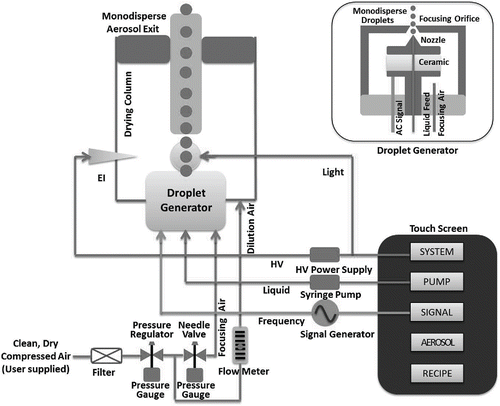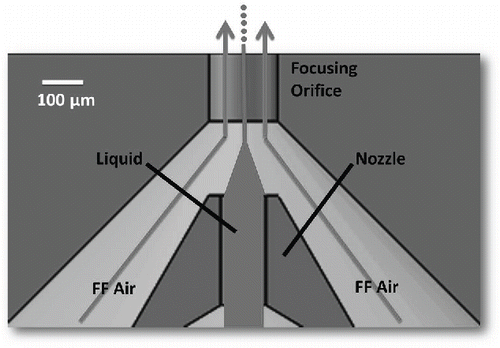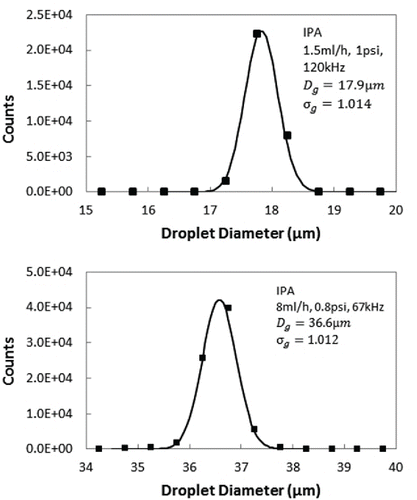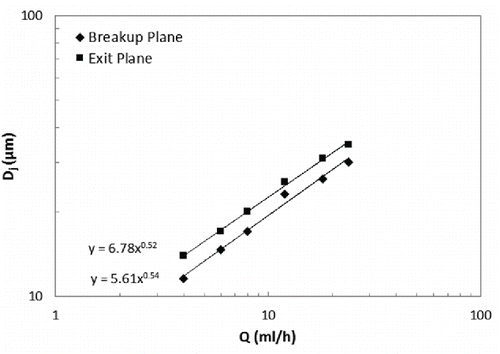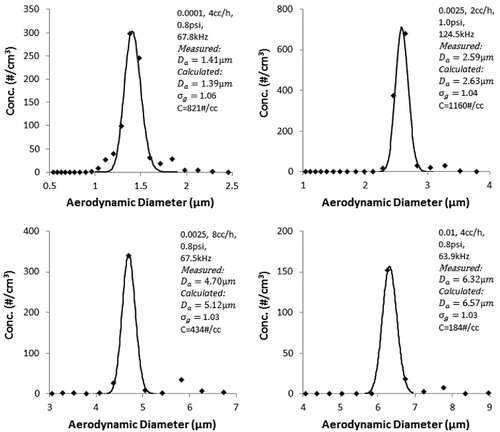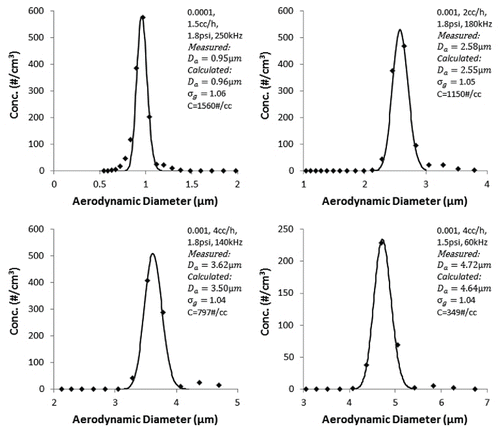ABSTRACT
A novel instrument has been developed for generating highly monodisperse aerosol particles with a geometrical standard deviation of 1.05 or less. This aerosol generator applies a periodic mechanical excitation to a micro-liquid jet obtained by aerodynamic flow-focusing. The jet diameter and its fastest growth wavelength have been optimized as a function of the flow-focusing pressure drop and the liquid flow rate. The monodisperse aerosol generated by this instrument is also charge neutralized with bipolar ions produced by a non-radioactive, corona discharge device. Monodisperse droplet generation in the 15- to 72-μm diameter range from a single 100-micron nozzle has been demonstrated. Both liquid and solid monodisperse particles can be generated from 0.7- to 15-μm diameter by varying solution concentration, liquid flow rate, and excitation frequency. The calculated monodisperse particle diameter agrees well with independent measurements. The operation of this new monodisperse aerosol generator is stable and reliable without nozzle clogging, typical of other aerosol generators at the lower end of the operating particle size ranges.
Copyright © 2016 American Association for Aerosol Research
EDITOR:
Introduction
Highly monodisperse aerosol particles with a known particle size and concentration are extensively used in a variety of applications such as instrument calibration, filter testing, particle deposition studies, health effect studies, and other fundamental aerosol research applications.
Typical aerosol generators that start from a liquid solution (i.e., atomizers, ultrasonic nebulizers) cannot produce monodisperse particles because of the random and chaotic breakup of bulk liquids. By comparison, a common method for achieving droplets of uniform size is the Berglund and Liu Citation(1973) aerosol generator, also known as the Vibrating Orifice Aerosol Generator (VOAG), which has been in use for the last 40 years. The working principle of the VOAG is to introduce a periodic mechanical pressure by a piezoelectric transducer to the liquid jet issuing from a pinhole (orifice) to achieve controlled jet breakup. The inkjet aerosol generator (Iida et al. Citation2014; Kesavan et al. Citation2014) is an on-demand droplet generator that works on the same principle as the VOAG, but with a much lower droplet generation rate, and aimed at producing monodisperse particle number concentration standards. The VOAG is known for its ability to generate extremely monodisperse aerosols with a geometrical standard deviation (GSD) < 1.05. However, the VOAG has two major limitations: First, the pinhole is prone to clogging because of its small diameter (i.e., 20 μm or less); second, each pinhole can only generate a limited droplet diameter range and frequency. Replacement of pinholes is required for generating different aerosol sizes.
To overcome these limitations, we developed the Flow-Focusing Monodisperse Aerosol Generator (FMAG) described in this article. The central innovation for the FMAG is that a single, 100-µm tapered nozzle generates the entire range of droplet diameters from 15 to 72-μm. Stable liquid jets with a diameter of 10 to 100 µm can be generated by aerodynamic flow-focusing (Gañán-Calvo Citation1998). The flow-focused jets are then subjected to periodic mechanical excitations similar to those used in the VOAG. In the applicable excitation frequency range, the jet undergoes a highly ordered breakup and forms extremely monodisperse droplets (Eggers and Villermaux Citation2008). The droplets thereafter are charge-neutralized with bipolar ions generated by an electrical ionizer and dried with clean air, during which the nonvolatile portion of the liquid solution results in a monodisperse aerosol with a number concentration from a few hundred to a few thousand particles/cm3, which can be easily transported by a flexible hose for specific testing purposes.
In the following sections, we discuss the detailed design, characterization, and performance of the FMAG. We show that highly monodisperse droplets with GSD < 1.02 in the 15 to 72-μm range can be generated.
Design of the FMAG
The flow-focusing monodisperse aerosol generator (FMAG) comprises the following four main components (): droplet generator, electrical ionizer (EI), drying column, and fluid and instrument control system.
The centerpiece of the droplet generator is the 100-µm ID-tapered nozzle and the flow-focusing orifice. A ring-shaped piezo-ceramic actuator is sandwiched between the tapered nozzle plate and the bottom connector plate (). The two plates also form the electrodes connected to the AC signal for mechanical excitation. This signal enables the piezo actuator to apply periodic mechanical perturbations to the liquid jet, resulting in the break up of micro-jet into highly monodisperse droplets (Berglund and Liu Citation1973). To ensure laminar flow and accurate alignment between the tapered nozzle and its focusing orifice (Vega et al. Citation2010), we designed a 150-µm ID convergent focusing orifice cover, which is concentric with the nozzle (). Clean airflow is introduced at a constant flow rate and pressure in the annular space between the tapered nozzle and the flow-focusing orifice. The liquid jet is accelerated by the focusing air, forming a micro-liquid jet up to 10 times smaller than the nozzle's inner diameter.
The droplets after break up immediately enter the drying column and are neutralized by an electrical ionizer and dried by the dilution air. The electrical ionizer comprises a single corona discharge electrode connected to a 5-kV rms AC voltage that creates packets of positive and negative ions emitted from the same electrode at the frequency of the input AC voltage (i.e., 50 or 60 Hz). The droplets are exposed to the high concentration of bipolar ions, which impart an equilibrium charge distribution to the monodisperse droplets. A metal tube on top of the droplet generator is used to transport the monodisperse aerosol with minimal aerosol recirculation and particle losses to the walls. The flow rate of dilution air is adjustable to provide sufficient drying air and aerosol flow for the user's intended application.
The fluid and instrument control system comprises clean-air lines, liquid feed line, syringe pump, frequency generator, high-voltage power supply, pressure gauges, flow meter for dilution air, flow control valves, and the main controller with a touch screen display.
General phenomenology
To evaluate the droplet generation monodispersity of the FMAG, high-speed images of the droplets being generated were recorded (Phantom V12.1, Vision Research Inc., Wayne, NJ, USA). The camera was coupled with a long working distance microscope and customized lens tube. The effective magnification was 26×, or 0.76 µm/pixel. illustrates that a wide range of isopropyl alcohol (IPA) droplets can be generated by adjusting the liquid flow rate, the flow-focusing pressure, and the excitation frequency. The images record the focused jet spurting out of the flow-focusing orifice and break up into droplets. The focusing air still accelerates the jet or droplets downstream of the orifice until its energy dissipates in the surroundings. This process has been verified by the droplet spacing (i.e., X1 equals X2 but is greater than X3).
Figure 3. Highly monodisperse droplets of IPA (images taken by a high-speed camera with 32,000 pps, 0.28-µs exposure time). X: droplet-to-droplet spacing; L: distance from orifice exit to breakup point.

By comparison, the breakup point of the unexcited flow-focused jet (i.e., Vac = 0) is always longer () than that of excited jets (
). It is important to point out that even though satellite droplets are formed during breakup for droplets smaller than 30 µm, they are absorbed by the primary droplets after a short distance, as evidenced by the absence of satellites in the downstream images (see 4 mL/h 1 psi and 2 mL/h 1 psi in ). This phenomenon was called “rear-merging” by Pimbley and Lee Citation(1977), and is beneficial for generating highly monodisperse droplets.
A phase doppler interferometer (PDI; 200MD, Artium Technologies Inc., Sunnyvale, CA, USA) was used to measure the droplet size distribution. The laser intersection of the PDI was placed roughly 5 mm away from the flow-focusing orifice and aligned with the stream of droplets. shows the size distribution of highly monodisperse IPA droplets with a measured average GSD of 1.013. In these droplet measurements, there are not satellite droplets, which may be produced at certain frequencies, nor are there doublets naturally produced during jet expansion and transport.
shows high-speed camera images for highly monodisperse ultrapure water (UPW) droplets. These droplets have a wider frequency range than those from IPA jets. This observation may be attributable to the higher surface tension of water, which leads to a smaller Ohnesorge number with otherwise comparable conditions (jet diameter and liquid viscosity). A smaller Ohnesorge number indicates that the viscous effect is less prominent in damping the oscillation and break up of the liquid jet.
The optimal excitation frequency can be determined from the Rayleigh's classical linear perturbation theory (Rayleigh Citation1878), which shows that excitations with wavelength longer than the circumference of the jet are unstable, and that the instability grows exponentially. A fastest growing wavelength exists:
[1] where λ is the wavelength, and Dj is the jet diameter. At a given excitation amplitude, the wavelength of
leads to the monodisperse breakup point nearest to the jet origin. The jet can also exhibit monodisperse breakup behavior in a wavelength range bracketing
. For example, Schneider and Hendricks Citation(1964) found an excitation frequency range for their apparatus based on an acoustic waveguide:
[2]
It is also intuitive to expect that excitations with higher amplitude may lead to a wider range of wavelengths exhibiting monodispersity because the stronger externally imposed perturbation has better opportunity to overwhelm any frequency from the background noise (Duan et al. Citation2013).
Tables and summarize the applicable frequency ranges (column 4) observed experimentally for each jet breaking up for IPA and UPW respectively, which are in agreement with Equations (Equation1[1] ) and (Equation2
[2] ). Tables and also indicate the recommended flow rate of dilution air. Tables and show that with the same orifice, monodisperse droplets from 15 to 72 µm can be produced by simply changing the liquid flow rate, spanning half an order of magnitude in diameter and two orders of magnitude in droplet volume. In particular, 15 to 40-µm droplets are recommended for generating monodisperse aerosols because droplets larger than 40 µm tend to have lower particle concentrations and more doublets.
Table 1. FMAG IPA operational table.
Table 2. FMAG UPW operational table.
Scaling laws for droplet diameter
To quantify the micro-jet diameters, high-speed images were processed under different conditions by adjusting the flow focusing pressure drop to achieve a steady jetting mode (Vega, et al. Citation2010). Flow-focusing pressure drops of 0.75 psi and 1.0 psi were used for IPA, and 1.4 psi and 1.8 psi were used for UPW. In particular, the experimental results were compared with the jet diameter scaling law derived in Gañán-Calvo Citation(1998):[3] where Dj is the jet diameter, ρl is the liquid density, ΔPg is the gas pressure drop, and Q is the liquid flow rate.
In , the measurements of the jet diameter for IPA jets at 1.0 psi were made from the camera images taken at both the location of the flow focusing orifice exit and a position before the breakup point (no frequency was applied to the piezo actuator during these measurements). shows similar measurements of jet diameters for UPW at 1.8 psi.
Figure 5. Highly monodisperse droplets of UPW (images taken by a high-speed camera with 32,000 pps, 0.28-µs exposure time).
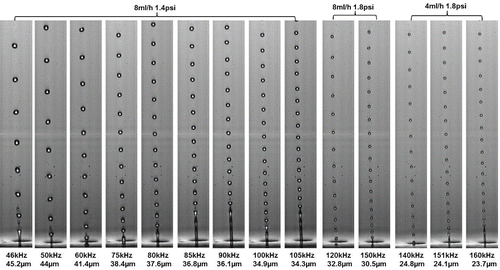
Two observations can be made. First, the jet is still being accelerated and continues to shrink for a certain distance (0.3–0.7 mm) in the air stream after exiting the focusing orifice. This acceleration will cause the actual jet diameter to deviate from the scaling law (Equation (Equation3[3] )). Second, the fitted formula from the experimental data has reasonable agreement with the scaling law, particularly at the exit plane. This correlation suggests that jet diameter behaves qualitatively as expected from theory, although Equation (Equation3
[3] ) over predicts the jet diameter, partially because of the post-orifice acceleration and thinning of the jet.
Monodisperse aerosol generation performance
Next, experiments were performed to measure the size distribution of liquid and solid particles. For this purpose, we selected oleic acid as the liquid aerosol because this is the most commonly used test aerosol for impactor calibrations (Marple et al. Citation2003). To generate solid particles, we selected sodium chloride (NaCl) because it is another very commonly used test aerosol for a variety of applications such as filter testing (Romay et al. Citation1998).
The monodisperse particles generated by the FMAG were measured by an aerosol spectrometer (Model 3320 Aerodynamic Particle Sizer [APS], TSI Inc., Shoreview, MN, USA) downstream of the instrument. The APS was used because of its excellent size resolution in spite of its limitations for measuring particles smaller than 1 μm and for measuring liquid particles larger than 5 μm.
The droplet diameter can be calculated directly from the FMAG operating conditions using Equation (Equation4[4] ),
[4] where Dd is the droplet diameter, Q is the liquid flow rate, and f is the excitation frequency.
The particle geometric diameter can be calculated from Equation (Equation5[5] ),
[5] where Dp is the geometric particle diameter, and C is the volume concentration of the nonvolatile solute in the solvent.
It should be noted that C should include any nonvolatile impurities in the solvent, and therefore the solvent purity must be ensured when generating small particles (i.e., below 1 μm).
For solid particles, the effect of nonspherical shape must be taken into account. This is normally done by incorporating the dynamic shape factor to correct for the slower settling velocity of nonspherical particles compared with that of their equivalent volume spheres, as shown in Equation (Equation6[6] ),
[6] where De is the equivalent volume diameter, and χ is the dynamic shape factor.
The aerodynamic diameter is the diameter of a sphere of unit density that has the same settling velocity as the particle, and it is calculated using Equation (Equation7[7] ),
[7]
Particles generated from the FMAG may carry high levels of electrical charge. Therefore, it is important to neutralize these particles as soon as they are generated to minimize losses by electrostatic effects during transport, and to ensure a stable monodisperse aerosol with a bipolar equilibrium charge distribution. Given that the use of radioactive neutralizers is strictly regulated by nuclear regulatory agencies, the FMAG was designed with a bipolar ion corona-based electrical ionizer. The effectiveness of this ionizer has been experimentally characterized by Kallinger et al. Citation(2012). The single ionizer electrode is located directly above the droplet generator and neutralizes the droplets immediately after breakup.
Nonvolatile aerosols, such as oleic acid, dissolved in methanol, and NaCl dissolved in UPW were generated by the FMAG. The volume concentrations of the liquid solutions used for the tests varied from 5.000E-5 to 0.05000. The properties of the liquid solvent such as density, surface tension, and viscosity were not affected in a significant way by the addition of nonvolatile solute substances.
Oleic acid particles in methanol droplets
Using the recommended operating parameters listed in , and using three different concentrations of oleic acid in methanol solutions, the dried and neutralized oleic acid particles were transported via a flexible hose and sampled by the APS. shows the number size distribution at four different conditions covering a diameter range from 1.4 to 6.6 μm. The mean diameters measured by the APS are in excellent agreement with the diameter calculated from Equations (Equation4[4] ), (Equation5
[5] ), and (Equation7
[7] ), as shown in . When particles become larger, the apparent disagreement between the calculated and measured aerodynamic diameters is due to the deformation of large oleic acid particles in the acceleration nozzle of the APS (Baron Citation1986). For particles smaller than 2 μm, the APS also shows a wider size distribution (i.e., σg = 1.06), a result of the reduced size resolution of the APS when measuring smaller particles (Chen et al. Citation1985). The GSD of the oleic acid monodisperse aerosols typically varies from 1.03 to 1.06. shows a small peak of doublets, which are produced by coagulation of two singlets. The fraction of doublets can be minimized by operating the FMAG at an optimum frequency and by increasing the focusing air and dilution airflow rates. The focusing air plays an important role in dispersing the aerosol to effectively reduce the doublets. Complete elimination of doublets can only be achieved by impacting them with a sharp adjustable cut-point impactor operating at a cut-point slightly below the size of the doublets (Siegford et al. Citation1994).
NaCl particles in UPW droplets
Sodium chloride particles in aqueous solution were also generated as an example of solid particles generated by the FMAG. shows the aerodynamic diameter distribution as measured by the APS. For the case of solid particles, the aerodynamic diameter was calculated using Equations (Equation4[4] ) to (Equation7
[7] ) to take into account the shape factor (i.e., 1.08 for cubic particles) to correct for nonsphericity effects and the density of the particles, which was assumed to be the same as the bulk density of NaCl (i.e., 2.16 g/cm3). The agreement between the measured and calculated aerodynamic diameter is within 5%. The GSD of the NaCl monodisperse aerosols varies from 1.04 to 1.06. An additional experiment was also carried out to collect the NaCl particles for scanning electron microscope (SEM) analysis. shows four pictures at four different magnifications for the case of 5.6-μm aerodynamic diameter particles. This figure illustrates the crystalline structure that results in the non-unity shape factor for NaCl particles.
Conclusions
A new instrument to generate highly monodisperse droplets and aerosol standards (σg < 1.02 for droplets, and σg < 1.06 for particles) combining aerodynamic flow focusing with a mechanical perturbation has been demonstrated experimentally. The FMAG can generate a wide size range of monodisperse aerosols (0.7 to 15 μm) by using a single 100-µm non-clogging nozzle capable of continuous, stable operation for several hours. The performance of FMAG was evaluated experimentally, and the parameters of operation were determined for optimum aerosol generation performance. The FMAG also incorporates a stable, non-radioactive aerosol neutralizer for optimum transport efficiency that delivers a mostly neutral aerosol standard that can be used for a variety of applications, including instrument calibration.
References
- Baron, P. A. (1986). Calibration and Use of the Aerodynamic Particle Sizer (APS 3300). Aerosol Sci. Tech., 5:55–67.
- Berglund, R. N., and Liu, B. Y. H. (1973). Generation of Monodisperse Aerosol Standards. Environ. Sci. Technol., 7:147–153.
- Chen, B. T., Cheng, Y. S., and Yeh, H. C. (1985). Performance of a TSI Aerodynamic Particle Sizer. Aerosol Sci. Tech., 4:89–97.
- Duan, H., Yang, W., Li, C., Lojewski, B., and Deng, W. (2013). Scalable Generation of Strictly Monodisperse Droplets by Transverse Electrohydrodynamic Excitations. Aerosol Sci. Tech., 47:1174–1179.
- Eggers, J., and Villermaux, E. (2008). Physics of Liquid Jets. Rep. Prog. Phys., 71(3):036601.
- Gañán-Calvo, A. M. (1998). Generation of Steady Liquid Microthreads and Micron-Sized Monodisperse Sprays in Gas Streams. Phys. Rev., 80.2:285.
- Kallinger, P., Steiner, G.. and Szymanski, W. W. (2012). Characterization of Four Different Bipolar Charging Devices for Nanoparticle Charge Conditioning. J. Nanopart. Res., 14:944.
- Kesavan, J. S., Bottiger, J. R., Schepers, D. R., and McFarland, A. R. (2014). Comparison of Particle Number Counts Measured with an Ink Jet Aerosol Generator and an Aerodynamic Particle Sizer. Aerosol Sci. Tech., 48(2), 219–227.
- Iida, K., Sakurai, H., Saito, K., and Ehara, K. (2014). Inkjet Aerosol Generator as Monodisperse Particle Number Standard. Aerosol Sci. Tech., 48(8), 789–802.
- Marple, V. A., Olson, B. A., Santhanakrishnan K., Mitchell, J. P., Murray, S. C., and Hudson-Curtis, B. L. (2003). Next Generation Pharmaceutical Impactor. Part II: Calibration. J. Aerosol Med., 16:301–324.
- Pimbley, W. T., and Lee, H. C. (1977). Satellite Droplet Formation in a Liquid Jet. IBM J. Res. Develop., 21(1):21–30.
- Rayleigh, Lord. (1878). On the Instability of Jets. Proc. Lond. Math. Soc., 10:4–13.
- Romay, F. J., Liu, B. Y. H. and Chae, S-J. (1998). Experimental Study of Electrostatic Capture Mechanisms in Commercial Electret Filters. Aerosol Sci. Tech., 28:224:234.
- Schneider, J. M., and Hendricks, C. D. (1964). Source of Uniform-Sized Liquid Droplets. Rev. Sci. Instrum., 35.10:1349–1350.
- Siegford, K. L., Marple, V. A.. and Rubow, K. L. (1994). A Multiplet Reduction Impactor for the Vibrating Orifice Aerosol Generator. J. Aerosol Sci., 25(S1):113–114.
- Vega, E. J., Montanero, J. M., Herrada, M. A., and Gañán-Calvo, A. M. (2010; 1994-present). Global and Local Instability of Flow Focusing: The Influence of the Geometry. Phys. Fluids, 22.6:064105.
- Yang, W., Duan, H., Li, C., and Deng, W. (2014). Crossover of Varicose and Whipping Instabilities in Electrified Microjets. Phys. Rev. Lett., 112:054501.

